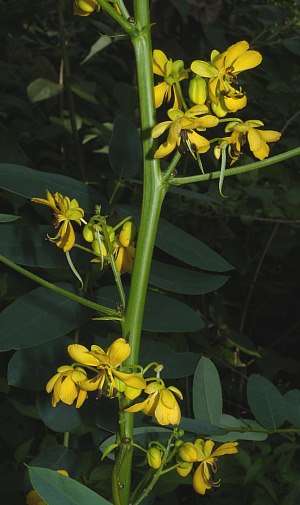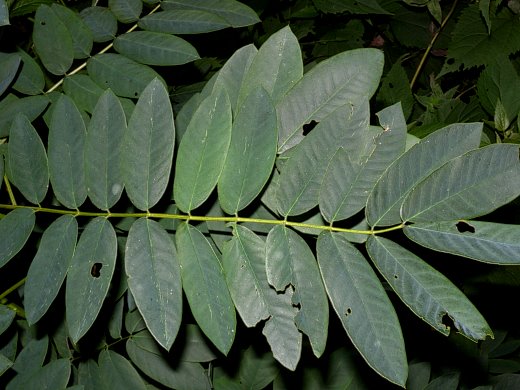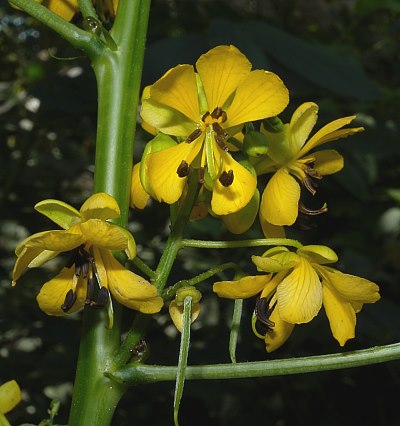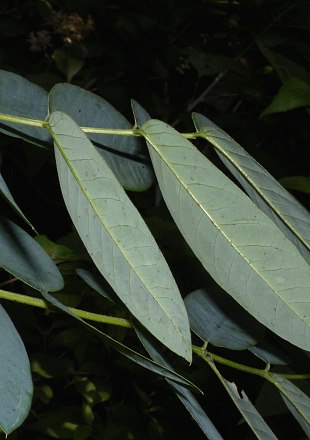
Both terminal and axillary inflorescences are produced. The terminal inflorescence is ½-1' long, consisting of either a raceme or panicle of flowers. The axillary inflorescences are up to ½' long, consisting of racemes of flowers. Individual flowers are about ¾" across, consisting of 5 spreading yellow petals, 5 spreading greenish yellow sepals, 10 stamens with dark brown anthers, and a pistil with a style that curls upward at its tip. The sepals are smaller than the petals; the former are joined together at the base and obovate in shape. The stamens are organized into three groups: the lower 3 stamens have long filaments and long anthers, the middle 4 stamens have short filaments and long anthers, while the upper 3 stamens have short filaments and short anthers. Of these, the lower and middle stamens are fertile, while the upper stamens are sterile. The slender green styles are covered with short appressed hairs. The flowers are without nectaries. The stalks of each inflorescence are green, often angular, and usually short-pubescent. The blooming period occurs from mid- to late summer for about 3-4 weeks.

Shortly afterwards, the flowers are replaced by drooping seedpods. These seedpods are narrowly oblong in shape and flattened with single-seeded segments. They are initially green and their sides are covered with appressed short hairs, but they become dark brown and more hairless at maturity, dividing into two parts along its length to release the seeds. Individual seeds are a little less than ¼" long, dark-colored, oblongoid-ovoid in shape, flattened, and more pointed on one end than the other. The shallow root system is fibrous and long-rhizomatous. Small colonies of clonal plants often develop from the rhizomes.
Cultivation: The preference is full or partial sun, moist well-drained conditions, and soil containing loam, sand, rocky material, or other soil types. The root system does not add nitrogen to the soil, unlike many species in the closely related Bean family (Fabaceae). This tall flowering plant is easy to cultivate in gardens.

Range & Distribution: The native Maryland Senna is widely distributed throughout Illinois, but it is relatively uncommon (see Distribution Map). Populations of this species appear to be declining. Habitats include moist prairies, openings in wooded areas, thickets, savannas, riverbanks, and limestone glades. Occasionally this wildflower is cultivated in gardens. In wooded natural areas, some disturbance is required to reduce competition from trees and shrubs.
Faunal Associations: The flowers are cross-pollinated by bumblebees, which collect pollen from the flowers. The extra-floral nectaries attract ants and occasionally flies, which feed on the nectar. The foliage of Maryland Senna and the closely related Wild Senna (Senna hebecarpa) is consumed by caterpillars of the butterflies Eurema nicippe (Sleepy Orange), Phoebis philea (Orange-barred Sulfur), and Phoebis sennae (Cloudless Sulfur). The foliage is also eaten by the caterpillars of Epargyreus clarus (Silver-Spotted Skipper) and Ascalapha odorata (Black Witch), while the flowers are eaten by caterpillars of the polyphagous moth, Pleuroprucha insulsaria (Common Tan Wave). A negro bug, Cydnoides ciliatus orientis, has been found in association with Maryland Senna, other Senna spp. (Sennas), and Cassia spp. (Partridge Peas); they are possible host plants of this insect. Because the foliage is somewhat toxic and cathartic, it is usually avoided by White-Tailed Deer and other mammalian herbivores.

Photographic Location: A woodland opening at Busey Woods in Urbana, Illinois.
Comments: A scientific synonym of this species is Cassia marilandica. Another common name of this wildflower is Southern Wild Senna, because its range doesn't extend as far north as a closely related species, Senna hebecarpa (Wild Senna). These two species are very similar in appearance and they are occasionally confused with each other. The flowers of Maryland Senna have styles with short appressed hairs, while the flowers of Wild Senna have styles with long spreading hairs. Maryland Senna also tends to produce fewer flowers than Wild Senna, although variations in environmental conditions can produce exceptions to this rule.